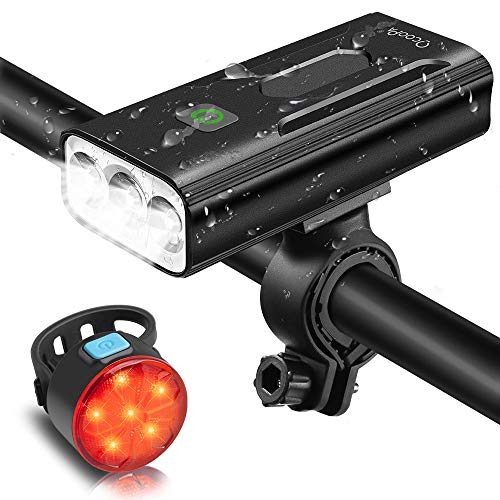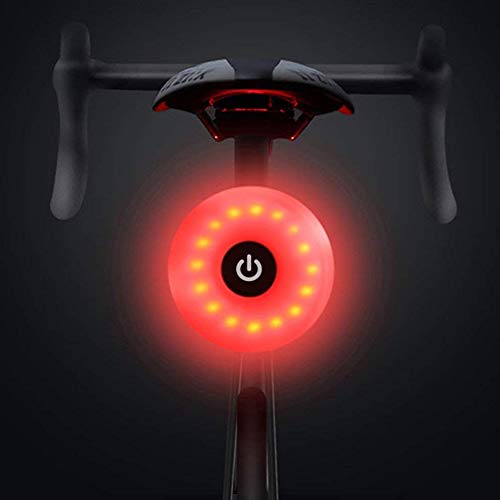This post may contain affiliate links, which help to keep Discerning Cyclist rolling. Learn more.
Cycling is great for our health. It’s also heaps of fun, and nothing quite beats that feeling of freedom that comes with cruising along a stunning scenic trail on your day off.
For many people, cycling is also a necessity. Bikes can be the vehicles that get us from A to B, whether that’s through bustling cities or idyllic rural villages. The riding experience is as enjoyable as it is necessary.
Like most things, though, cycling doesn’t come without its risks. Whether you’re cycling to work or school or simply enjoying a freedom ride in your free time, we all know the hazards of other motorists, cyclists, pedestrians, and wildlife. You need to see and be seen consistently.
To do this, you’ll need to know exactly how bright your bike lights should be. There’s no definitive answer to this question, but by understanding lumens and light settings, you can arm yourself with the knowledge needed to navigate those roads or trails safely.
What is a Good Brightness for a Bike Light?
Cyclists travelling through well-lit areas should aim for a 100- or 200- lumen light. If you’re cycling through unlit areas and need to increase visibility, you’ll need a higher lumen count. Anywhere between 200 to 600 lumens is ideal, especially for commuters.
To be more precise, your front lights will need to be double the lumens of your rear light. Rear lights are generally not as bright as front lights. Most measure between 100 and 180 lumens.
Your cycling conditions are the biggest factor to consider before purchasing a bike light. Remember: well-lit areas will automatically increase your visibility, so you can safely install lights with a lower lumen count.
In rural, unlit areas, you’ll need to make yourself stand out like a sore thumb. With fewer light sources and more blind bends, the higher the lumen count, the safer you’ll be.
Can Bike Lights Be Too Bright?
Yes! If lights aren’t used properly or positioned at the correct angle, they can blind other pedestrians, cyclists, and motorists.
A headlight pointed directly upwards will go straight into the line-of-sight of pedestrians. To avoid this, you’ll need to angle your beam correctly.
Start by choosing whether you want your light on the right or left side of your handlebars. Ideally, your beam should illuminate areas up to 10-20 meters in front of you. Your beam should always be pointed towards the ground and angled to hit the curb.
If you’re riding at higher speeds, your light should be angled higher. If you’re riding slower, your light should be angled lower so you can see pedestrians and other motorists clearly.
How Many Lumens Should a Bike Light Be?
There is no one-size-fits-all when it comes to lumens. The ideal count will depend on whether you’re night riding, day riding, travelling through urban areas, or cruising on unlit roads.
Bike lights can also be split into two categories – lights to improve your vision and lights to make you more noticeable. Choosing lights with a higher lumen count can help you fit into both categories without the need to buy separate lights for each purpose.
The right lumen count will also depend on the conditions you’re cycling in. Let’s take a closer look at the ideal lumen count for the most typical cycling environments.
Lit Urban Areas
Well-lit city streets are teeming with light sources. From street lamps to storefront lights and car headlights, your visibility is automatically improved. If you’re cycling in the daytime, you’ll need 100+ lumens.
For night riding, you’ll need anywhere between 50 to 200 lumens. This will depend on how lit up your urban area is. More external light sources will usually require a smaller lumen count.
No products found.
Unlit Roads
To cycle safely on unlit roads (especially rural ones) you’ll need between 400 to 600 lumens for maximum visibility. Without external lighting, your vision will be impaired significantly, and you’ll be less visible to drivers. A higher lumen count will keep you, other motorists, pedestrians, and wildlife as safe as possible.
You should also consider flashing vs. solid lights. Ophthalmologists have confirmed that flashing lights are more likely to grab our attention than solid lights. Many clip-on bike lights come with rapid flashing options that send a consistent signal to motorists that you’re on the road, so you’ll never have to worry about not being seen. This is crucial when you’re travelling on unlit roads.
- HIGH-QUALITY BIKE LIGHTS SET WITH RELIABLE VISIBILITY- USB rechargeable front and back light set include 5200mAh Headlight and 1200mAh Taillight, this cycling lights set allows strobe or steady beam...
- DURABLE & COMPACT BODY- Hard shell is made of aluminum alloy, makes this bike light durable and strong. And it is compact and portable with a metal hook, features IPX5 waterproof and dustproof,...
- ADJUSTABLE BRIGHTNESS- Both the white front light and red rear light support different lighting mode. LED bike light features a 3 LED bulb which is 100000 hours lifetime and 1200 lumen brightness....
Front Lights vs Rear Lights
As rear bike lights are made to make you visible to other road users rather than light your route, they aren’t typically as bright as front lights. Most rear bikes go up to 100 lumens, so the closer you can get to this number, the better.
Your front lights will automatically be far brighter, and you should use our above guide on lit and unlit roads to inform your choice.
Remember: you can also buy bike lights that can switch between day and night modes and adjust their brightness accordingly. If you regularly cycle between lit and unlit areas, these are a great choice that allows for more versatility and freedom.
- ✅ MULTIFUNCTIONAL SAFETY LIGHT: Easy to install. Lightweight and durable bike tail light that can be mounted on all bikes, children's bike, adult bicycle, handlebars, seat posts, dog collars or...
- ✅ SET YOUR OWN LIGHT MODES: 5 light mode options: Strobe(9 hours), Slow Strobe(56 hours), Meteor Flash(14 hours), Tai Chi Flash(17 hours), Breathing Flash(8 hours). You can switch different modes...
- ✅ NO BATTERIES REQUIRED: Built in USB charge port for this bike rear light (USB cable included). Please charge it when the indicator light is red. It will turn green when fully charged
How Bright Should a Bike Light Be?
Remember: bike lights aren’t just for night riding. Though they’re not legally required for day riding, they can help you improve your visibility and make you more noticeable to motorists.
You should now know everything you need to know about lumens, but remember, you’ll still need to choose the type of light you want carefully.
For your own safety, you need to be visible at all times. The last thing any cyclist needs is for their lights to die out mid ride. Instead of opting for standard, battery-powered lights, consider other options like rechargeable lights or even self-powered bike lights that generate energy through a hub in your bike’s wheel!
There are so many options to choose from, so you’ll never be short of ways to stay safe (and have fun) on the roads!

